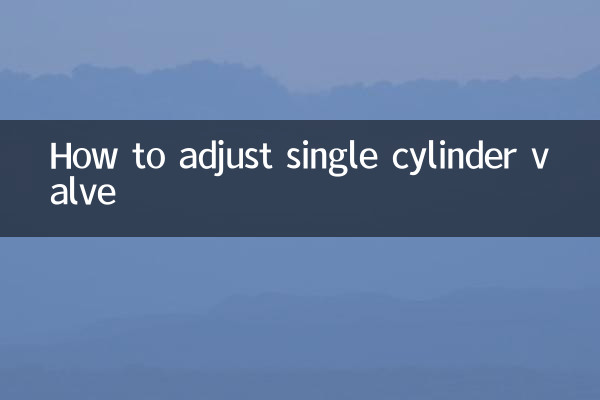How to adjust single cylinder valve
Recently, car repair and motorcycle maintenance have become one of the hot topics, especially the valve adjustment method of single-cylinder engines that has attracted much attention. This article will introduce in detail the steps, precautions and related data of single-cylinder valve adjustment to help car owners and maintenance personnel better complete this operation.
1. Basic principles of single-cylinder valve adjustment

Valve adjustment is a critical step in ensuring proper engine operation. Excessive valve clearance in a single-cylinder engine will increase noise, while too small a clearance will affect the sealing of the valve, thereby reducing engine performance. Therefore, it is very important to check and adjust the valve clearance regularly.
2. Single cylinder valve adjustment steps
1.Preparation: Make sure the engine is cool and prepare the required tools, such as feeler gauges, wrenches, etc.
2.Remove valve cover: Remove the valve cover to expose the valve mechanism.
3.Determine top dead center: Rotate the crankshaft so that the piston is at the top dead center position of the compression stroke.
4.Measure valve clearance: Use a feeler gauge to measure the valve clearance and record the current value.
5.Adjust valve clearance: Based on the measurement results, loosen the locking nut and adjust the adjusting screw until the gap reaches the standard value.
6.Tighten and recheck: Tighten the locking nut and measure the valve clearance again to ensure accurate adjustment.
3. Standard data for single-cylinder valve adjustment
| Engine type | Intake valve clearance (mm) | Exhaust valve clearance (mm) |
|---|---|---|
| Single cylinder air-cooled | 0.05-0.10 | 0.08-0.12 |
| Single cylinder water cooling | 0.06-0.11 | 0.09-0.13 |
4. Precautions
1. When adjusting the valve clearance, be sure that the engine is in a cooling state to avoid measurement errors caused by thermal expansion and contraction.
2. When using the feeler gauge, pull gently and feel a slight resistance to find the appropriate gap.
3. After the adjustment is completed, it is necessary to rotate the crankshaft several times and recheck the clearance to ensure that the adjustment is accurate.
4. If the valve clearance is found to change frequently, it may be that the valve or valve seat is worn, and further inspection is required.
5. Common problems and solutions
| question | Possible reasons | Solution |
|---|---|---|
| Loud valve noise | The gap is too large | Readjust to standard value |
| Engine power is insufficient | Gap too small | Adjust clearance and check valve tightness |
| The gap is unstable | Valve train wear | Replace worn parts |
6. Summary
Single-cylinder valve adjustment is a highly technical job, but with the right steps and tools, it can be done by yourself. Regularly checking and adjusting valve clearance not only extends engine life, but also improves vehicle performance. If you are not familiar with the operation, it is recommended to seek help from professional maintenance personnel.
Recently, there has been a lot of discussion about single-cylinder engine maintenance, especially novice car owners who have more questions about valve adjustment. I hope that the detailed explanation in this article can help you better master this skill.

check the details

check the details